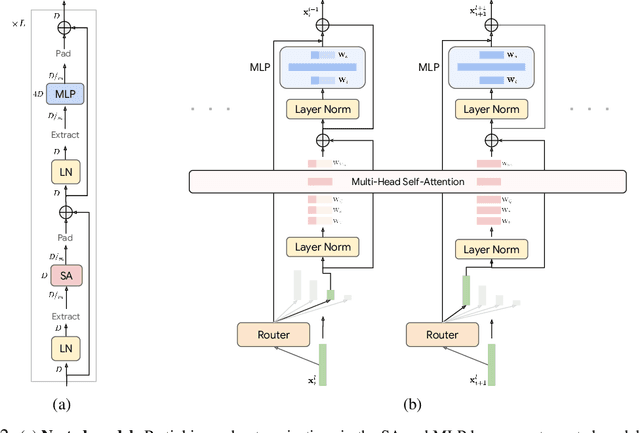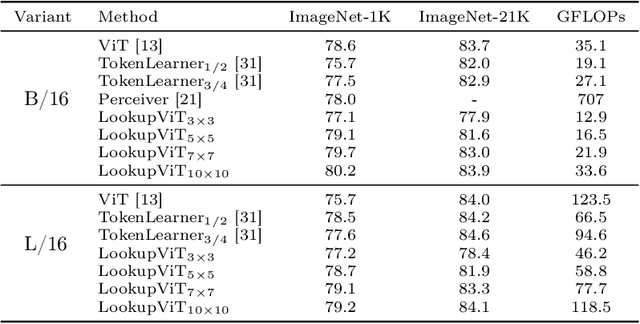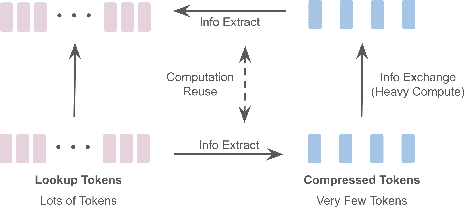Prateek Jain
Spark Transformer: Reactivating Sparsity in FFN and Attention
Jun 07, 2025Abstract:The discovery of the lazy neuron phenomenon in trained Transformers, where the vast majority of neurons in their feed-forward networks (FFN) are inactive for each token, has spurred tremendous interests in activation sparsity for enhancing large model efficiency. While notable progress has been made in translating such sparsity to wall-time benefits, modern Transformers have moved away from the ReLU activation function crucial to this phenomenon. Existing efforts on re-introducing activation sparsity often degrade model quality, increase parameter count, complicate or slow down training. Sparse attention, the application of sparse activation to the attention mechanism, often faces similar challenges. This paper introduces the Spark Transformer, a novel architecture that achieves a high level of activation sparsity in both FFN and the attention mechanism while maintaining model quality, parameter count, and standard training procedures. Our method realizes sparsity via top-k masking for explicit control over sparsity level. Crucially, we introduce statistical top-k, a hardware-accelerator-friendly, linear-time approximate algorithm that avoids costly sorting and mitigates significant training slowdown from standard top-$k$ operators. Furthermore, Spark Transformer reallocates existing FFN parameters and attention key embeddings to form a low-cost predictor for identifying activated entries. This design not only mitigates quality loss from enforced sparsity, but also enhances wall-time benefit. Pretrained with the Gemma-2 recipe, Spark Transformer demonstrates competitive performance on standard benchmarks while exhibiting significant sparsity: only 8% of FFN neurons are activated, and each token attends to a maximum of 256 tokens. This sparsity translates to a 2.5x reduction in FLOPs, leading to decoding wall-time speedups of up to 1.79x on CPU and 1.40x on GPU.
Faster Approx. Top-K: Harnessing the Full Power of Two Stages
Jun 05, 2025Abstract:We consider the Top-$K$ selection problem, which aims to identify the largest-$K$ elements from an array. Top-$K$ selection arises in many machine learning algorithms and often becomes a bottleneck on accelerators, which are optimized for dense matrix multiplications. To address this problem, \citet{chern2022tpuknnknearestneighbor} proposed a fast two-stage \textit{approximate} Top-$K$ algorithm: (i) partition the input array and select the top-$1$ element from each partition, (ii) sort this \textit{smaller subset} and return the top $K$ elements. In this paper, we consider a generalized version of this algorithm, where the first stage selects top-$K'$ elements, for some $1 \leq K' \leq K$, from each partition. Our contributions are as follows: (i) we derive an expression for the expected recall of this generalized algorithm and show that choosing $K' > 1$ with fewer partitions in the first stage reduces the input size to the second stage more effectively while maintaining the same expected recall as the original algorithm, (ii) we derive a bound on the expected recall for the original algorithm in \citet{chern2022tpuknnknearestneighbor} that is provably tighter by a factor of $2$ than the one in that paper, and (iii) we implement our algorithm on Cloud TPUv5e and achieve around an order of magnitude speedups over the original algorithm without sacrificing recall on real-world tasks.
Matryoshka Model Learning for Improved Elastic Student Models
May 29, 2025Abstract:Industry-grade ML models are carefully designed to meet rapidly evolving serving constraints, which requires significant resources for model development. In this paper, we propose MatTA, a framework for training multiple accurate Student models using a novel Teacher-TA-Student recipe. TA models are larger versions of the Student models with higher capacity, and thus allow Student models to better relate to the Teacher model and also bring in more domain-specific expertise. Furthermore, multiple accurate Student models can be extracted from the TA model. Therefore, despite only one training run, our methodology provides multiple servable options to trade off accuracy for lower serving cost. We demonstrate the proposed method, MatTA, on proprietary datasets and models. Its practical efficacy is underscored by live A/B tests within a production ML system, demonstrating 20% improvement on a key metric. We also demonstrate our method on GPT-2 Medium, a public model, and achieve relative improvements of over 24% on SAT Math and over 10% on the LAMBADA benchmark.
Efficient Single-Pass Training for Multi-Turn Reasoning
Apr 25, 2025



Abstract:Training Large Language Models ( LLMs) to generate explicit reasoning before they produce an answer has been shown to improve their performance across various tasks such as mathematics and coding. However, fine-tuning LLMs on multi-turn reasoning datasets presents a unique challenge: LLMs must generate reasoning tokens that are excluded from subsequent inputs to the LLM. This discrepancy prevents us from processing an entire conversation in a single forward pass-an optimization readily available when we fine-tune on a multi-turn non-reasoning dataset. This paper proposes a novel approach that overcomes this limitation through response token duplication and a custom attention mask that enforces appropriate visibility constraints. Our approach significantly reduces the training time and allows efficient fine-tuning on multi-turn reasoning datasets.
Interleaved Gibbs Diffusion for Constrained Generation
Feb 19, 2025Abstract:We introduce Interleaved Gibbs Diffusion (IGD), a novel generative modeling framework for mixed continuous-discrete data, focusing on constrained generation problems. Prior works on discrete and continuous-discrete diffusion models assume factorized denoising distribution for fast generation, which can hinder the modeling of strong dependencies between random variables encountered in constrained generation. IGD moves beyond this by interleaving continuous and discrete denoising algorithms via a discrete time Gibbs sampling type Markov chain. IGD provides flexibility in the choice of denoisers, allows conditional generation via state-space doubling and inference time scaling via the ReDeNoise method. Empirical evaluations on three challenging tasks-solving 3-SAT, generating molecule structures, and generating layouts-demonstrate state-of-the-art performance. Notably, IGD achieves a 7% improvement on 3-SAT out of the box and achieves state-of-the-art results in molecule generation without relying on equivariant diffusion or domain-specific architectures. We explore a wide range of modeling, and interleaving strategies along with hyperparameters in each of these problems.
Matryoshka Quantization
Feb 10, 2025Abstract:Quantizing model weights is critical for reducing the communication and inference costs of large models. However, quantizing models -- especially to low precisions like int4 or int2 -- requires a trade-off in model quality; int2, in particular, is known to severely degrade model quality. Consequently, practitioners are often forced to maintain multiple models with different quantization levels or serve a single model that best satisfies the quality-latency trade-off. On the other hand, integer data types, such as int8, inherently possess a nested (Matryoshka) structure where smaller bit-width integers, like int4 or int2, are nested within the most significant bits. This paper proposes Matryoshka Quantization (MatQuant), a novel multi-scale quantization technique that addresses the challenge of needing multiple quantized models. It allows training and maintaining just one model, which can then be served at different precision levels. Furthermore, due to the co-training and co-distillation regularization provided by MatQuant, the int2 precision models extracted by MatQuant can be up to $10\%$ more accurate than standard int2 quantization (using techniques like QAT or OmniQuant). This represents significant progress in model quantization, demonstrated by the fact that, with the same recipe, an int2 FFN-quantized Gemma-2 9B model is more accurate than an int8 FFN-quantized Gemma-2 2B model.
Does Safety Training of LLMs Generalize to Semantically Related Natural Prompts?
Dec 04, 2024



Abstract:Large Language Models (LLMs) are known to be susceptible to crafted adversarial attacks or jailbreaks that lead to the generation of objectionable content despite being aligned to human preferences using safety fine-tuning methods. While the large dimensionality of input token space makes it inevitable to find adversarial prompts that can jailbreak these models, we aim to evaluate whether safety fine-tuned LLMs are safe against natural prompts which are semantically related to toxic seed prompts that elicit safe responses after alignment. We surprisingly find that popular aligned LLMs such as GPT-4 can be compromised using naive prompts that are NOT even crafted with an objective of jailbreaking the model. Furthermore, we empirically show that given a seed prompt that elicits a toxic response from an unaligned model, one can systematically generate several semantically related natural prompts that can jailbreak aligned LLMs. Towards this, we propose a method of Response Guided Question Augmentation (ReG-QA) to evaluate the generalization of safety aligned LLMs to natural prompts, that first generates several toxic answers given a seed question using an unaligned LLM (Q to A), and further leverages an LLM to generate questions that are likely to produce these answers (A to Q). We interestingly find that safety fine-tuned LLMs such as GPT-4o are vulnerable to producing natural jailbreak questions from unsafe content (without denial) and can thus be used for the latter (A to Q) step. We obtain attack success rates that are comparable to/ better than leading adversarial attack methods on the JailbreakBench leaderboard, while being significantly more stable against defenses such as Smooth-LLM and Synonym Substitution, which are effective against existing all attacks on the leaderboard.
* Accepted at the Safe Generative AI Workshop @ NeurIPS 2024
Time-Reversal Provides Unsupervised Feedback to LLMs
Dec 03, 2024



Abstract:Large Language Models (LLMs) are typically trained to predict in the forward direction of time. However, recent works have shown that prompting these models to look back and critique their own generations can produce useful feedback. Motivated by this, we explore the question of whether LLMs can be empowered to think (predict and score) backwards to provide unsupervised feedback that complements forward LLMs. Towards this, we introduce Time Reversed Language Models (TRLMs), which can score and generate queries when conditioned on responses, effectively functioning in the reverse direction of time. Further, to effectively infer in the response to query direction, we pre-train and fine-tune a language model (TRLM-Ba) in the reverse token order from scratch. We show empirically (and theoretically in a stylized setting) that time-reversed models can indeed complement forward model predictions when used to score the query given response for re-ranking multiple forward generations. We obtain up to 5\% improvement on the widely used AlpacaEval Leaderboard over the competent baseline of best-of-N re-ranking using self log-perplexity scores. We further show that TRLM scoring outperforms conventional forward scoring of response given query, resulting in significant gains in applications such as citation generation and passage retrieval. We next leverage the generative ability of TRLM to augment or provide unsupervised feedback to input safety filters of LLMs, demonstrating a drastic reduction in false negative rate with negligible impact on false positive rates against several attacks published on the popular JailbreakBench leaderboard.
Mixture of Nested Experts: Adaptive Processing of Visual Tokens
Jul 29, 2024



Abstract:The visual medium (images and videos) naturally contains a large amount of information redundancy, thereby providing a great opportunity for leveraging efficiency in processing. While Vision Transformer (ViT) based models scale effectively to large data regimes, they fail to capitalize on this inherent redundancy, leading to higher computational costs. Mixture of Experts (MoE) networks demonstrate scalability while maintaining same inference-time costs, but they come with a larger parameter footprint. We present Mixture of Nested Experts (MoNE), which utilizes a nested structure for experts, wherein individual experts fall on an increasing compute-accuracy curve. Given a compute budget, MoNE learns to dynamically choose tokens in a priority order, and thus redundant tokens are processed through cheaper nested experts. Using this framework, we achieve equivalent performance as the baseline models, while reducing inference time compute by over two-fold. We validate our approach on standard image and video datasets - ImageNet-21K, Kinetics400, and Something-Something-v2. We further highlight MoNE$'$s adaptability by showcasing its ability to maintain strong performance across different inference-time compute budgets on videos, using only a single trained model.
LookupViT: Compressing visual information to a limited number of tokens
Jul 17, 2024



Abstract:Vision Transformers (ViT) have emerged as the de-facto choice for numerous industry grade vision solutions. But their inference cost can be prohibitive for many settings, as they compute self-attention in each layer which suffers from quadratic computational complexity in the number of tokens. On the other hand, spatial information in images and spatio-temporal information in videos is usually sparse and redundant. In this work, we introduce LookupViT, that aims to exploit this information sparsity to reduce ViT inference cost. LookupViT provides a novel general purpose vision transformer block that operates by compressing information from higher resolution tokens to a fixed number of tokens. These few compressed tokens undergo meticulous processing, while the higher-resolution tokens are passed through computationally cheaper layers. Information sharing between these two token sets is enabled through a bidirectional cross-attention mechanism. The approach offers multiple advantages - (a) easy to implement on standard ML accelerators (GPUs/TPUs) via standard high-level operators, (b) applicable to standard ViT and its variants, thus generalizes to various tasks, (c) can handle different tokenization and attention approaches. LookupViT also offers flexibility for the compressed tokens, enabling performance-computation trade-offs in a single trained model. We show LookupViT's effectiveness on multiple domains - (a) for image-classification (ImageNet-1K and ImageNet-21K), (b) video classification (Kinetics400 and Something-Something V2), (c) image captioning (COCO-Captions) with a frozen encoder. LookupViT provides $2\times$ reduction in FLOPs while upholding or improving accuracy across these domains. In addition, LookupViT also demonstrates out-of-the-box robustness and generalization on image classification (ImageNet-C,R,A,O), improving by up to $4\%$ over ViT.
 Add to Chrome
Add to Chrome Add to Firefox
Add to Firefox Add to Edge
Add to Edge